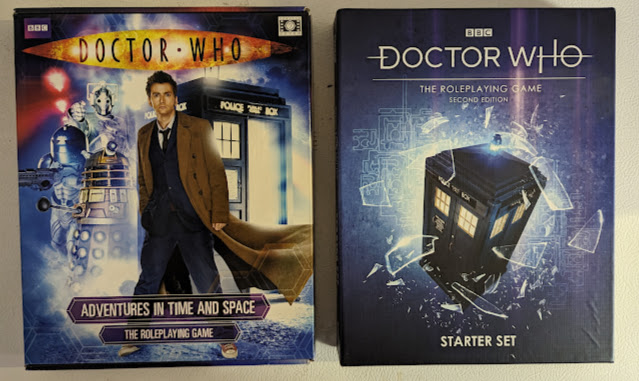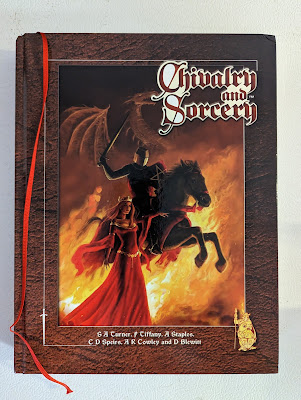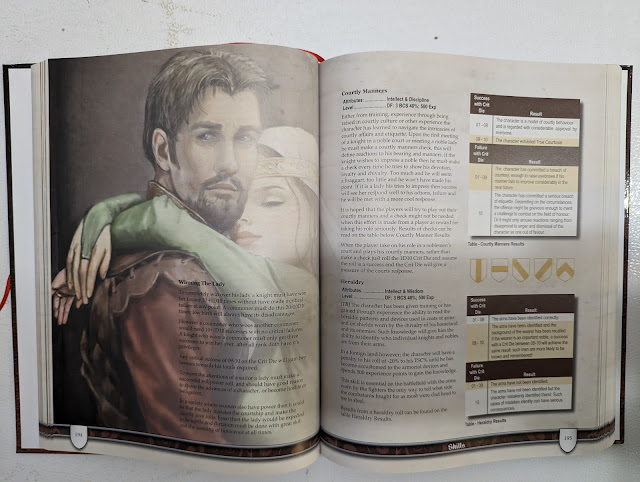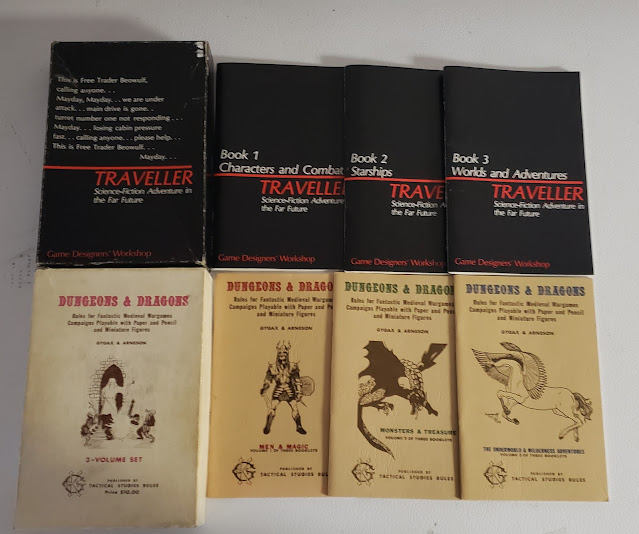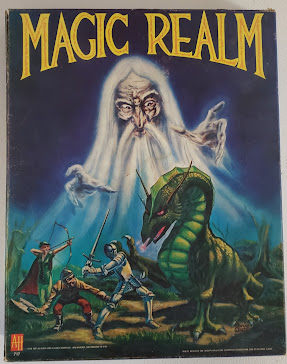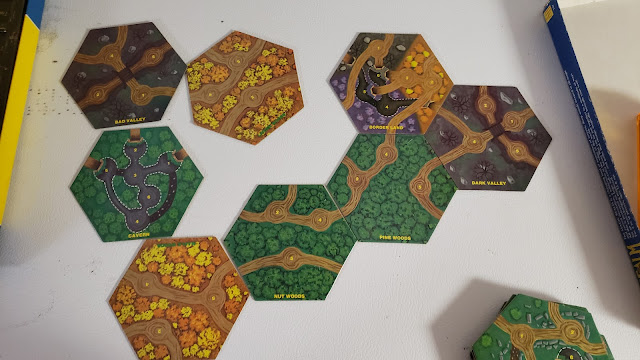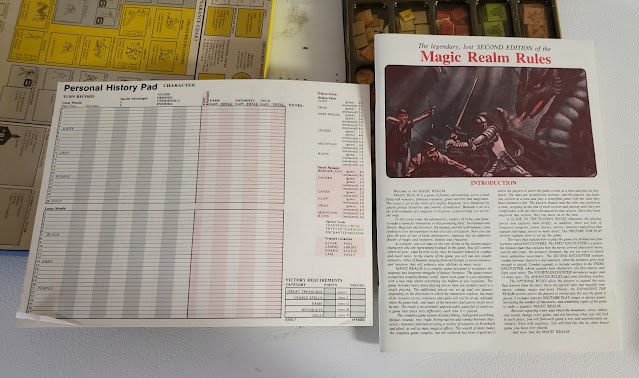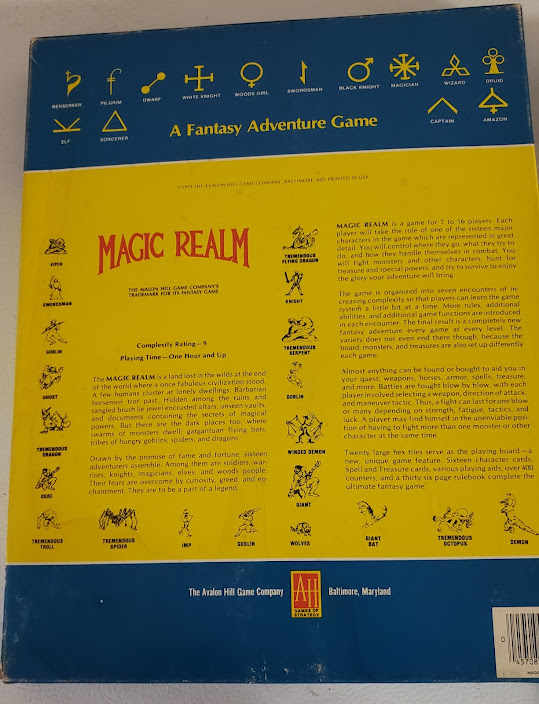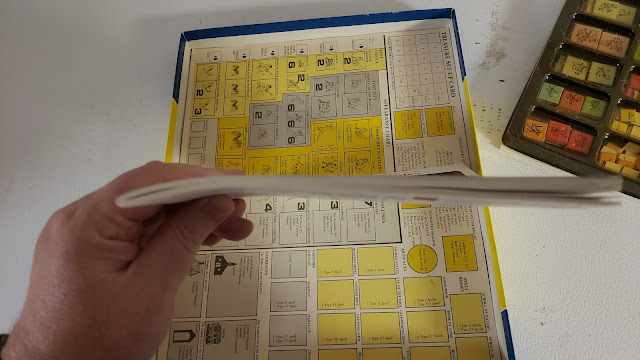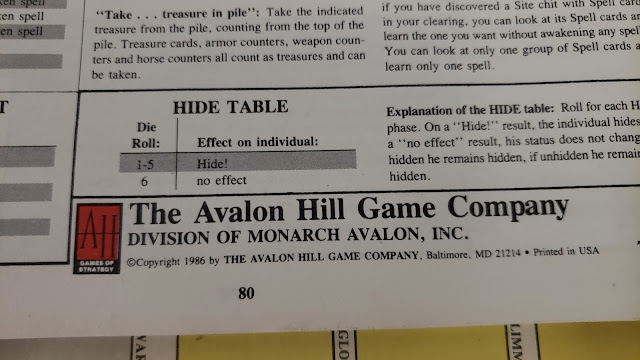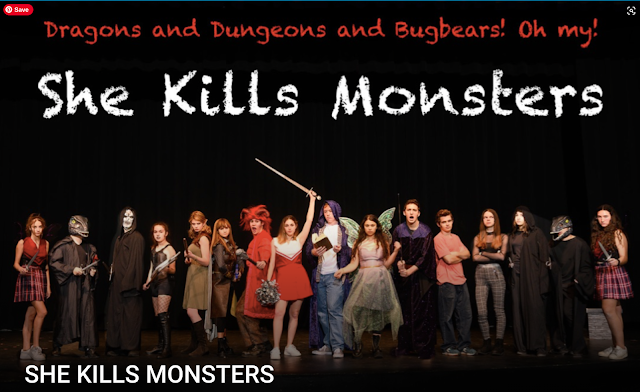It's May and I want to spend the entire month talking about Sci-Fi RPGs, and most of this month talking about Traveller. Traveller has a long and storied history in both the RPG world and for me personally. It is the second (or the third, more on that) RPG I ever owned after D&D.
I say second but my memory is foggy and it could have been Traveller or it could have been Chill. I think for my horror cred I like to claim it was Chill, but in the early 80s, I was all about Science Fiction. So really it was most likely to be Traveller. I picked up the Traveller Book and tried to teach to it to myself, but my groups were very D&D focused and no one wanted to play it. The groups that did play it were all older than I was and they did not want some "D&D kid" in their "Serious Sci-Fi" groups. I was able to more traction on Star Frontiers a few years later. Must have been the TSR bias of the time. I do wish I still had my original Traveller Book though. I did manage to score an Original Traveller boxed set of the "Little Black Books" so I guess that is even better.
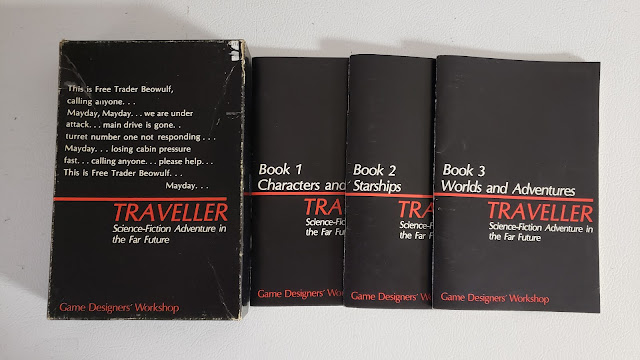
Today I am going to review Traveller and start at the very beginning. There is just no way I could through everything for Traveller. I'd need more than a month, I'd need a whole new blog, so instead, I was going to going to concentrate on some core products to get people into the game and a few choice ones that have meaning to me.
I will admit right up front that I am no Traveller expert. So it is very, very likely I will miss a few a things. Just let me, and others, know in the comments.
Ok, as my friend Greg said on Sunday, let's get this party started!
Classic Traveller
For this review, I am going to be referring to my 1977 Game Designers' Workshop edition of the boxed set of Traveller. I am also joining to be comparing them the PDFs of the Classic Traveller Facsimile Edition from Game Designers' Workshop / Far Future Enterprises on DriveThruRPG.
Side Note: Far Future Enterprises bought the rights to various GDW games a while back and published this pdf as far back as 2001. They own the rights to republish Traveller, 2300 AD, Twilight: 2000, and Dark Conspiracy. They also work with Mongoose and other publishers of Traveller material. But more on that in future posts. Suffice to say that from my point of view they have been carrying the torch of Traveller high since 2000. Among other things they publish a full CD-ROM of Traveller material that I would love to grab someday.
The Boxed Set
The Traveller Boxed Set from GDW was released in 1977. GDW was located in Normal, IL which is along what I learned was a trail the lead from Lake Geneva, WI, and Chicago, IL all the way down to the University of Illinois in Urbana, IL, Illinois State in Normal, IL down to Southern Illinois Univerity in Carbondale, IL. Tim Kask was an SIU grad, GDW was in Normal, Mayfair would later be founded in Skokie just outside of Chicago, and Judges Guild was founded in Decatur, IL. I basically grew up surrounded by the growing Table Top RPG scene.
Much like Dungeons & Dragons of the time, Traveller came in a digest-sized box with three books. Instead of there being "3 Little Brown Books" there are "3 Little Black Books." Also, like D&D future printings would combine these books though in different ways.
PDF Note: The Classic Traveller Facsimile Edition also includes a preface for the whole set of books and gives a brief history of their publications. This is a great value-add for the PDF. According to it what I am reviewing today is "Basic Traveller" and published in 1981. Basic Revised was published in 1981 and the Traveller Book (my first purchase) was in 1982.
Book 1: Characters and Combat
This is the character generation book and maybe one of the most famous bit of RPG lore ever. Yes. In Traveller you can die in Character creation!
I should also point out that very, very often in my conversations with people over the years that Character Creation for Travelller was very much in line with what we would call "Session 0" today. Everyone worked on their character, developed a back story (yes in 1977) and then got together. Even the starting character example is a 42-year-old with a pension (and a cutlass it seems). Trust me, at 42 I already had backstory (and a wife, kids, a mortgage, bills...)
Character creation is largely a random affair, but not wholly so. There are choices to be made along the way. How a character acquires skills and expertise largely depends on which service they were in and how they got there. You can enlist or you can be drafted. At this point, all characters were assumed to have served in some form of the service. Citizens don't mortgage their pension on a beat second-hand starship to go galavanting across known space.
As you work through character creation you can go for a few terms of service. This gives you more skill, more experience, more credits, and makes you older. As in real life, there are benefits and detriments to age.
Skills are detailed next. This is going to come up again and again, but let's talk about it here first. The Computers of Traveller are the computers of 1977. Not very advanced and require special expertise to use them. Today of course I am writing this post in one window, monitoring email and chat in another, watching the weather in another, and reading the PDF in yet another. I have dozens of active programs running that I am paying attention to and who knows how many more running in the background. I am not going to apply 21st-century biases though to these rules. Let's just leave them as-is for now and see how future versions of this game treat it. For me I am going to assume there are computers (with a lower case c) that do all the work we think of today and anyone can use and then there are specialized Computers (with an upper case C) that do specialized work, like today's supercomputers.
Side Note: The best super-computer of 1977 was the 80mhz, 64 bit Cray-1. It cost $8M and was capable of 160 MFLOPS. For comparison, my three-year-old smartphone runs at 130ghz and is capable of 658 GFLOPS. Newer phones are more than double that. 4000x's the power at 1/10,000th of the cost. And I can put it into my pocket.
After your terms of service are figured out along with your skills then comes the time to learn combat. Combat always gets more ink than say hacking a computer since there are so many things going on and a failure usually means death. Also, as an aside, there are a lot of bladed weapons in Traveller. I attribute this to two different elements. The first and obvious is Star Wars, though Traveller obviously draws more from Dune than Star Wars which only came out in May of 77. The other and likely more important source is D&D. For the obvious reasons. The end effect is that officers in Traveller often carry swords in my mind.
Combat gives us our basic roll for the game and the introduction of the Traveller basic mechanic. The PDF is a little clearer on this than my print book. Roll 2d6 and beat a roll of 8. This is modified by various skills and experiences.
Wounds affect the character's Strength, Dexterity, and Endurance. The more wounds you get, the worse those stats are. D&D would not do this in earnest until 4th Edition.
PDF Notes: My copy is dedicated "To Mary Beth" and the PDF (and I think the Traveller Book) are dedicated "To Darlene." There are other minor differences as well. The PDF for example has a "Personal Data and History" aka a Character Sheet on page 28 (36 for the PDF).
Book 2: Starships
This is what makes Traveller, well, Traveller. There are two types of travel dealt with here, Interplanetary (worlds within the same star system) and Interstellar (different star systems). Also if you are afraid of math this book is going to give you a bad day.
The main focus of this book in my mind is buying a starship and keeping it running. Starships are expensive and in Traveller, those expenses are more keenly felt than say keeping up a castle in D&D. If your castle runs out of food you can leave to go buy some. In a starship, in space, your options are more limited. In space, no one can hear your stomach grumble.
I have no idea if the economies of Traveller work. I mean is 2 tons of fuel really worth the year's salary of a gunner? No idea. I am going to handwave that and say it works.
There is also a lot on Starship construction here too. Before I could get anyone to play I would write up sheets of starships and their costs based on what I thought was cool. Kinda wish I had a couple of those. The only one I can remember was the FTL Lucifer. It was designed to be small, but fast. It would later make it's way into Star Frontiers, but that is another tale.
We get some details on starship combat and some basic world data.
Book 2 also covers experience and various drugs. I get the feeling these were put here to pad out Book 2 so all three books were the same size; 44 pages.
PDF Notes: The PDF has more art, in particular how to orbit a planet and the necessary equations made more clear. Like Book 1 for Characters, this volume has sheets for ships. The PDF also adds a Trade and Commerce section.
Book 3: Worlds and Adventures
This book covers worlds. And if there was one thing I did more than creating starships that never traveled to other worlds, it was to create worlds that starships would never travel to. World creation was fun.
This book also covers various personal equipment and various encounter types.
Note at this point there are no aliens, no Imperiums, and really nothing other than the most basic adventuring outline. Very much like OD&D in that respect. I like the psionic system in Traveller and maybe I should explore the differences between it and the one in Eldritch Wizardry for D&D.
The last part of this book covers Psionics. Maybe one of the reasons I like to draw a pretty hard line between Magic and Psionics is that one is for Fantasy (and D&D) and the other is for Sci-Fi (and Traveller).
PDF Notes: The PDF again has more art (vehicles) as well as hex maps for working out star systems.
Final Notes
How does one review a classic like Traveller? How does one compare an RPG from 1977 to the standards of 2022? It's not easy under normal circumstances, but with Traveller it is easier. Why? Because so much of this game was ahead of its time you could brush it off, get some d6s and play it out of the box as is today. More so than OD&D is I think.
But both games are classics, no, Classics. With that capital C. It is no wonder that now, 45 years later, Traveller is still the goto science-fiction game.
As I move through the editions and versions I'll also talk about all the other materials that have been used with Traveller (board games for example) and how these "3LBBs" expanded to cover an entire universe.

